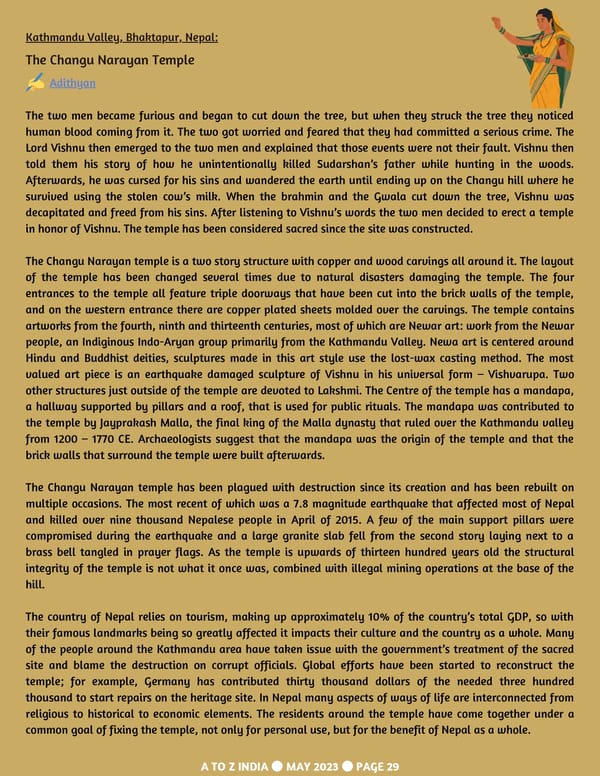Kathmandu Valley, Bhaktapur, Nepal: The Changu Narayan Temple Adithyan The two men became furious and began to cut down the tree, but when they struck the tree they noticed human blood coming from it. The two got worried and feared that they had committed a serious crime. The Lord Vishnu then emerged to the two men and explained that those events were not their fault. Vishnu then told them his story of how he unintentionally killed Sudarshan’s father while hunting in the woods. Afterwards, he was cursed for his sins and wandered the earth until ending up on the Changu hill where he survived using the stolen cow’s milk. When the brahmin and the Gwala cut down the tree, Vishnu was decapitated and freed from his sins. After listening to Vishnu’s words the two men decided to erect a temple in honor of Vishnu. The temple has been considered sacred since the site was constructed. The Changu Narayan temple is a two story structure with copper and wood carvings all around it. The layout of the temple has been changed several times due to natural disasters damaging the temple. The four entrances to the temple all feature triple doorways that have been cut into the brick walls of the temple, and on the western entrance there are copper plated sheets molded over the carvings. The temple contains artworks from the fourth, ninth and thirteenth centuries, most of which are Newar art: work from the Newar people, an Indiginous Indo-Aryan group primarily from the Kathmandu Valley. Newa art is centered around Hindu and Buddhist deities, sculptures made in this art style use the lost-wax casting method. The most valued art piece is an earthquake damaged sculpture of Vishnu in his universal form – Vishvarupa. Two other structures just outside of the temple are devoted to Lakshmi. The Centre of the temple has a mandapa, a hallway supported by pillars and a roof, that is used for public rituals. The mandapa was contributed to the temple by Jayprakash Malla, the final king of the Malla dynasty that ruled over the Kathmandu valley from 1200 – 1770 CE. Archaeologists suggest that the mandapa was the origin of the temple and that the brick walls that surround the temple were built afterwards. The Changu Narayan temple has been plagued with destruction since its creation and has been rebuilt on multiple occasions. The most recent of which was a 7.8 magnitude earthquake that affected most of Nepal and killed over nine thousand Nepalese people in April of 2015. A few of the main support pillars were compromised during the earthquake and a large granite slab fell from the second story laying next to a brass bell tangled in prayer flags. As the temple is upwards of thirteen hundred years old the structural integrity of the temple is not what it once was, combined with illegal mining operations at the base of the hill. The country of Nepal relies on tourism, making up approximately 10% of the country’s total GDP, so with their famous landmarks being so greatly affected it impacts their culture and the country as a whole. Many of the people around the Kathmandu area have taken issue with the government’s treatment of the sacred site and blame the destruction on corrupt officials. Global efforts have been started to reconstruct the temple; for example, Germany has contributed thirty thousand dollars of the needed three hundred thousand to start repairs on the heritage site. In Nepal many aspects of ways of life are interconnected from religious to historical to economic elements. The residents around the temple have come together under a common goal of fixing the temple, not only for personal use, but for the benefit of Nepal as a whole. A TO Z INDIA ● MAY 2023 ● PAGE 29
 A TO Z INDIA - MAY 2023 Page 28 Page 30
A TO Z INDIA - MAY 2023 Page 28 Page 30